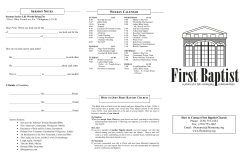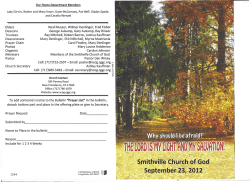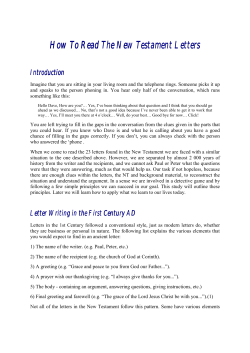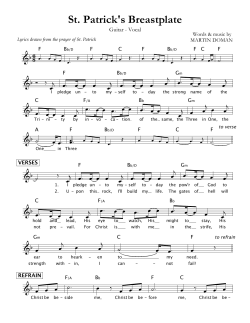
“How to Prepare a Sermon” 1. KNOW WHAT THE BIBLE SAYS ABOUT PREACHING
“How to Prepare a Sermon” Men’s Breakfast Baxter T. Exum, evangelist Four Lakes Church of Christ Madison, Wisconsin October 9, 2010 1. KNOW WHAT THE BIBLE SAYS ABOUT PREACHING • • • • “I solemnly charge you in the presence of God and of Christ Jesus, who is to judge the living and the dead, and by His appearing and His kingdom: preach the word; be ready in season and out of season; reprove, rebuke, exhort, with great patience and instruction” (2 Timothy 4:1‐2). “Since you have in obedience to the truth purified your souls for a sincere love of the brethren, fervently love one another from the heart, for you have been born again not of seed which is perishable but imperishable, that is, through the living and enduring word of God. For, ‘ALL FLESH IS LIKE GRASS, AND ALL ITS GLORY LIKE THE FLOWER OF GRASS. THE GRASS WITHERS, AND THE FLOWER FALLS OFF, BUT THE WORD OF THE LORD ENDURES FOREVER.’ And this is the word which was preached to you” (1 Peter 1:23‐25). “For since in the wisdom of God the world through its wisdom did not come to know God, God was well‐pleased through the foolishness of the message preached to save those who believe” (1 Corinthians 1:21). “And when I came to you, brethren, I did not come with superiority of speech or of wisdom, proclaiming to you the testimony of God. For I determined to know nothing among you except Jesus Christ, and Him crucified. I was with you in weakness and in fear and in much trembling, and my message and my preaching were not in persuasive words of wisdom, but in demonstration of the Spirit and of power, so that your faith would not rest on the wisdom of men, but on the power of God” (1 Corinthians 2:1‐5). 2. PRAY • • • “Devote yourselves to prayer, keeping alert in it with an attitude of thanksgiving; praying at the same time for us as well, that God will open up to us a door for the word, so that we may speak forth the mystery of Christ, for which I have also been imprisoned; that I may make it clear in the way I ought to speak” (Colossians 4:2‐4). “With all prayer and petition pray at all times in the Spirit, and with this in view, be on the alert with all perseverance and petition for all the saints, and pray on my behalf, that utterance may be given to me in the opening of my mouth, to make known with boldness the mystery of the gospel, for which I am an ambassador in chains; that in proclaiming it I may speak boldly, as I ought to speak” (Ephesians 6:18‐20). “But if any of you lacks wisdom, let him ask of God, who gives to all generously and without reproach, and it will be given to him” (James 1:5). Page 2 of 10 3. DEVELOP A FILE SYSTEM • • • • • • Create a folder for every book of the Bible (can be expanded later to include a folder for every chapter of the Bible—1,189 folders)—at home, I now have six 5‐drawer file cabinets (30 drawers) Create folders on major subjects (Attendance, Baptism, Bible, Church, Death, Elders, Evolution, Family, Fellowship, Giving, God, Grace, Holy Spirit, Jesus Christ, Lord’s Supper, Lying, Man, Marriage, Mental Health, Music, Prayer, Satan, Woman, Worship). These are just the highlights, and each of these can eventually be subdivided into sub‐folders (Baptism, Baptism‐Age of Accountability, Baptism‐EIS, Baptism‐Formula, Baptism‐Immersion, Baptism‐ Purpose, Baptism‐Rebaptism, Baptism‐Water, etc.). The need for more folders will be obvious as you start collecting material Use 1/3 cut reinforced file folders Good quality Steelcase file cabinets can be purchased for a reasonable price from UW SWAP (http://www.bussvc.wisc.edu/swap/inventory.html) Get on some good mailing lists (see Resources for Preachers), and file the material as it arrives Stay on the lookout for news stories, tracts at congregations where you visit, etc., and file the material in the appropriate place. Much of this you may never see again, but when you decide to preach on Matthew 6 (for example), hopefully there will be something useful in that folder. 4. DECIDE ON A TEXT (OR TOPIC) • • • • • • • Remember the old recipe for rabbit stew. Step 1: Catch the Rabbit For ideas: Rely on your daily Bible reading, reading in general (magazines, newspapers, books), Internet, life experiences; ask your wife and kids “The Bible is more up‐to‐date than this morning’s newspaper.” Keep a pen and paper by the nightstand and in the car. Consider preaching on a Bible character (Moses, David, Peter, Paul, etc.), a Psalm, a miracle of Jesus, a parable of Jesus, etc. Ask the congregation—people have some awesome ideas Expository vs. Topical (a very important decision) o Expository Preaching “The communication and application of a Biblical concept from one passage of Scripture.” “The communication of a Biblical concept, derived from and transmitted through a historical, grammatical, and literary study of a passage in its context, which the Holy Spirit first applies to the personality and experience of the preacher, then through him to his hearers” (Haddon W. Robinson). Based on a paragraph/thought‐block/chunk of Scripture (i.e., the passage governs the sermon…not the other way around) Advantages: • Emphasizes the wisdom of God • Enables systematic study of the entire Bible (over time) Page 3 of 10 • Allows the preacher to cover difficult subjects (a study through 1 Corinthians, for example, allows for a study of religious division, church discipline, the role of women, spiritual gifts, giving, etc.) Bonus: Even if the preacher “fails,” at least the congregation considered a paragraph of God’s word. Expository preaching is not to be confused with taking a passage and using it to teach lessons that are not really supported by the text itself. For example, a lesson supposedly from 2 Samuel 18:29 (KJV) poses the question, “Is the young man safe?” and then makes the following main points: • Is the young man safe from peer pressure? • Is the young man safe from alcohol? • Is the young man safe from drugs? Ouch! This has nothing to do with what this passage is actually about. The preacher may be speaking the truth about peer pressure, alcohol, and drugs, but to use this passage to do it is an atrocity and a serious abuse of the Scriptures! o Topical Preaching Based on a topic—some concepts can only be covered this way; for example, a year or so ago, someone asked why we worship on Sunday—there is not one main passage that adequately addresses this issue; so, we looked at several reasons why we worship on Sunday, and we went to several different passages. Can easily be abused, “Here is what I believe, and now I will go out there and find thirty verses (taken out of context) to support what I believe.” My view: A sermon should not be judged by the number of Scripture references in it but by whether it communicates a Biblical concept. 5. STUDY THE TEXT • • • • • Throughout the entire process, ask several very important questions: o So what? o Why did the Holy Spirit include this passage in the Bible? o What does this passage mean? o What did this passage mean to the original audience? o How does this passage affect MY life? A sermon must be applied to the preacher first. One definition of preaching, “A good man, speaking well” (Cicero). Study the passage several times in several different translations Study the context (the surrounding verses); 90% of false doctrines can be refuted by looking at the verse before and the verse after the verse that is quoted in support of the doctrine. Study related passages o Cross references o Concordance o Bible software Study the important words in the passage (look for repetition or special emphasis) Page 4 of 10 6. DEVELOP AN OUTLINE • • • NOTE: If at all possible, answer the “So what?” question and develop some kind of outline BEFORE going to the commentaries and other resources. The lesson should attempt to communicate the “So what?” through a series of “points” (normally between 2‐5). With more than 5 ideas, it is easy to lose people over the course of a lesson. Some sermons, of course, end up being “pointless” (not good)! Examples: o The Good Samaritan (Luke 10:30‐37) The Priest The Levite The Samaritan o Seven Things God Hates (Proverbs 6:16‐19) Haughty Eyes Lying Tongue Hands that Shed Innocent Blood A Heart that Devises Wicked Plans Feet that Run Rapidly to Evil A False Witness that Utters Lies One Who Spreads Strive Among Brothers 7. BEEF UP THE OUTLINE WITH IN‐DEPTH RESEARCH • • • • Again, only proceed with the in‐depth research AFTER determining the main concept and developing a rough outline (if at all possible). This helps to make sure that the sermon is “yours” and is not overly influenced by the thoughts of others. Preparation is time‐consuming and is hard work, but it must be done. o An old rule‐of‐thumb in public speaking: Half an hour of preparation for every minute of speaking; so, for a thirty‐minute lesson? At least fifteen hours! o “The only defensible speech is one that is the product of thorough preparation. The price that must be paid for the privilege of standing before an audience is work—long and thorough study” (Batsell Barrett Baxter). o One way of looking at it: If a preacher speaks to 50 people for half an hour, he has used up 25 hours of their collective time, and he must earn the right to do that. o When asked how long it would take him to prepare for a 10‐minute speech, Woodrow Wilson said, “Two weeks.” For an hour‐long speech? “One week.” For a two‐hour speech? “I am ready right now.” In other words, it is much easier to ramble, but an effective lesson requires a lot of thought and research. Consult commentaries, on‐line resources, Bible dictionaries, encyclopedias, etc., and use these resources to add “meat to the bones” of the outline. [see Resources for Preachers] What are some disadvantages of copying someone else’s sermon? o Study is important to keep the preacher strong in God’s word o If we come to rely to heavily on one person’s preaching, what happens if they drift away from the truth and become unfaithful? o It can represent a degree of dishonesty (plagiarism)—if someone else’s sermon helped you to a large degree, try make a note of that at the end of the lesson before posting it on the Internet (at a minimum) Page 5 of 10 • Recordkeeping o Number the lesson and number everything you look at (a stamp is helpful for this) o On the lesson itself, list your name, where the sermon is preached, and the date 8. WRITE THE SERMON • • • • • • • Write the lesson with the congregation “looking over your shoulder.” In other words, constantly keep them in mind as you write. A sermon can be a little like coming back from a vacation and explaining the experience to the congregation—not a literal vacation, but the preacher has traveled deep into the word of God, and he is trying to explain some of what he experienced on that journey—a little like unpacking a suitcase and sharing some of the pictures, stories, and souvenirs from the trip. Illustrate! o As we sometimes say, “A picture is worth…a thousand words.” o Illustrations should support the main concept—not just a story for the sake of a story, not just to get a laugh. o Jesus used MANY illustrations (word pictures)—sowing and reaping, birds, building a tower, a log in your eye, etc. Writing Style o Use the K.I.S.S. method (Keep It Simple, Stupid) o “Never use a big word when a smaller word will get the point across” (Tommy Exum). o Try to be understood by the 3rd graders, and yet still try to challenge the adults in the audience (Ray Exum). o Remember what Paul said, “…my message and my preaching were not in persuasive words of wisdom, but in demonstration of the Spirit and of power…” (1 Corinthians 2:4). o Consider the Sermon on the Mount; although delivered roughly on a 3rd grade level, and although it rarely has any words more than two syllables, it is one of the greatest sermons ever preached! PowerPoint o Michael Hite from the Bear Valley Bible Institute (Denver, CO) o Keep it simple (no full text, and no bizarre text effects)—this helps keep the focus on God and His message, not how good (or bad) the preacher is with a computer. o High contrast (due to the lighting in our church building)—white letters on a black background seems to work very well Introduction o Attention‐getting (quote, story, question, etc.) o Stating the need for such a study o To give the congregation some idea of where the lesson is heading—Tell ‘em what you’ll tell ‘em, tell ‘em, and tell ‘em what you told ‘em. Conclusion o To summarize o To call for action (not all action involves walking down the aisle) o ALWAYS include God’s plan of salvation (Evel Knievel sermon in Ohio). Page 6 of 10 9. REHEARSE AND REVISE • • • • Preach to a mirror and/or a video camera For difficult or unusual words: www.dictionary.com has a “pronounce” feature! Use the rehearsal time to time the lesson and whack what is not absolutely necessary— eliminate or rewrite sections that are confusing. Personally, I leave home at 6 a.m. on Sunday and whack the lesson over breakfast. I then rehearse it at least twice from the pulpit between 7‐9 a.m. (crossing stuff out, making notes in the margins, underlining for emphasis, making sure the PowerPoint looks good and works, etc.) Length of the Sermon o My goal: 23 minutes (the Golden Rule) o The mind can absorb only as much as the seat can stand! o Consider: How long can I hold the attention of this audience? o Good speakers can go much longer, but I find that I start really losing people at about 32 minutes—people start snoring, babies start crying, etc.! o “A sermon, to be immortal, need not be eternal.” o “Stand up, speak up, shut up!” 10. DELIVER • • • • • Enlarged Conversation—there is no need to use a “preacher voice,” but the delivery of a sermon could be compared to simply having a conversation (only a little louder) Nervousness o Keeps the preacher on his toes! o The best way to keep nervousness under control is to be well‐prepared. o Choose an interesting subject (like a kid talking about going to summer camp) o Think about the lesson and your audience, not about yourself. o My prayer on the front pew before the lesson: Help me not to offend anyone, unless they need to be offended; and then, allow me to do it in the kindest way possible. Use me! Eye contact o “Think of your line of vision as a kind of invisible bridge over which your ideas flow into the minds of your listeners” (Batsell Barrett Baxter). o Try to look directly at each person in the audience for 2‐3 seconds all throughout the lesson o Do not look over people’s heads or always down at your notes (rehearsal helps) Volume o Speak up and use the mic! Get in “the bubble.” o When speaking somewhere for the first time, I try to get there early to test out the sound system, and then I have my wife tug her ear during the lesson if she can’t hear me. Critique Sheet—ask for feedback from others Page 7 of 10 Conclusion: • There is a real need for preachers today! Many churches in the Upper Midwest have simply stopped looking for a full‐time preacher. • If you are still in school or if you can still go back to MATC, etc., try to take as many speech classes as possible. In high school, consider joining the NFL, the National Forensic League (basically a club for public speaking where you go to speech tournaments on the weekends). • Attend a good brotherhood lectureship (I attend the Freed‐Hardeman Bible Lectures every year) • To get more practice: o Fill‐in at Four Lakes when I am either sick or out‐of‐town. o Offer to present an explanation of a song (or give some background on the author of a song) during the fourth‐Wednesday song service. o Look for opportunities for filling‐in where preachers are needed (Platteville, Wausau, etc.) Page 8 of 10 Suggested Resources for Preachers “When you come bring the cloak which I left at Troas with Carpus, and the books, especially the parchments” (2 Timothy 4:13). Church Bulletins: Other Publications: Weber Road Church of Christ 5253 Weber Road Corpus Christi, TX 78411 South Florida Avenue Church of Christ 1807 South Florida Avenue Lakeland, FL 33803 Windsong Church of Christ POB 228 Little Rock, AR 72203 Mablevale Church of Christ POB 345 Mabelvale, AR 72103 Church of Christ at Bybee Branch 1165 Old Smithville Road McMinnville, TN 37110 Eastside Church of Christ 2141 Kingston Muskogee, OK 74403 Nesbit Church of Christ 685 Nesbit Road Nesbit, MS 38651 Bellview Church of Christ 4850 Saufley Field Road Pensacola, FL 32526 Seagoville Church of Christ 510 N. Kaufman Seagoville, TX 75159 Spring Church of Christ 1327 Spring Cypress Road Spring, TX 77383 Rockford Avenue Church of Christ 829 South Rockford Avenue Tulsa, OK 74120 South Seminole Church of Christ 5410 Lake Howell Road Winter Park, FL 32792 Magnolia Messenger POB 1578 Kosciusko, MS 39090 Power POB 128 Southaven, MS 38671 Preacher Talk, by Cecil May, Jr. cmay@faulkner.edu Daily Bread by Neal Pollard: NealP@bearvalleycofc.org http://preacherpollard.wordpress.com/ Paid Subscriptions: Rocky Mountain Christian ($14/year) POB 803 Eastlake, CO 80614 Gospel Advocate ($16.98/year) 1006 Elm Hill Pike Nashville, TN 37210 Spiritual Sword ($8/year) 1511 Getwell Road Memphis, TN 38111 Leadership Journal ($22/year) (denominational, but with some good articles on current issues facing churches in general) http://www.christianitytoday.com/le/ 465 Gundersen Drive Carol Stream, IL 60188 Online Resources: www.christiancourier.com www.apologeticspress.org www.sermoncentral.com (denominational, but with some good material searchable by scripture reference) www.google.com (search: sermon John 3:16, etc.) www.wikipedia.org (check the references) Reference Books: The Bible (NASB, ESV, NIV, etc.) An Exhaustive Concordance (matching the translation you use most often; not needed if you use Bible software) Zondervan Bible Dictionary Holman Bible Dictionary The International Standard Bible Encyclopedia (Vols. 1‐4) A Harmony of the Gospels (NASB), by Robert Thomas and Stanley Gundry Encyclopedia of Bible Difficulties, by Gleason Archer Questions and Answers (Vols. 1‐2), by Guy N. Woods Various Lectureship Books (Florida School of Preaching, East Tennessee School of Preaching, Spiritual Sword, Freed‐Hardeman University, etc.) Wiersbe’s Expository Outlines on the Old Testament/New Testament (2 vols.) and The Bible Exposition Commentary (2 vols.), by Warren Wiersbe (denominational, but he has some good ideas for expository outlines) Books about Preaching: Man of God, edited by Shawn Mathis Speaking for the Master, by Batsell Barrett Baxter Biblical Preaching, by Haddon W. Robinson Software: Gospel Advocate Bible Study Library, Deluxe Edition (9+ Bible translations, commentaries by members of the Lord’s church, ISBE, Greek dictionaries, maps, etc.) $100‐$150, depending on sale price www.biblegateway.com – A good website for looking up a passage in MANY different translations Where to purchase resources: www.amazon.com www.gospeladvocate.com; (800) 251‐8446 https://fhu.site‐ym.com/store/; (800) 342‐1869 Further Training: Nashville School of Preaching (http://www.crievehall.org/Nashville_School_of_Preaching/) East Tennessee School of Preaching and Missions (http://www.etspm.org/) Bear Valley Bible Institute of Denver (http://www.wetrainpreachers.com/) Florida School of Preaching (www.fsop.net) Freed‐Hardeman University (http://www.fhu.edu) Polishing the Pulpit (www.polishingthepulpit.com) Page 10 of 10 Sermon Evaluation Form “As iron sharpens iron, so one man sharpens another” (Proverbs 27:17). Speaker: ___________________________________________________ Date: ________________________________ Subject: _____________________________________________________ Text: ________________________________ Key (circle one): 5=Very Good 4=Good 3=Fair 2=Poor 1=Very Poor CONTENT 5 4 3 2 1 — 1. Did he open with effective introductory remarks? 5 4 3 2 1 — 2. Was the lesson well‐organized? 5 4 3 2 1 — 3. Was there an evident central purpose? 5 4 3 2 1 — 4. Was the central purpose the communication of a Biblical concept? 5 4 3 2 1 — 5. Was the Biblical concept drawn primarily from one thought‐block of Scripture? 5 4 3 2 1 — 6. Was the Biblical concept responsibly interpreted in context? 5 4 3 2 1 — 7. Was the subject appropriate for the audience? 5 4 3 2 1 — 8. Had he done sufficient preparation and research? 5 4 3 2 1 — 9. Was the message meaningfully applied to the hearers? 5 4 3 2 1 — 10. Were effective illustrations used? 5 4 3 2 1 — 11. Was the lesson Biblically accurate? 5 4 3 2 1 — 12. Were the concluding remarks accurate and effective? DELIVERY 5 4 3 2 1 — 13. Did he keep the lesson moving? 5 4 3 2 1 — 14. Was he grammatically correct? 5 4 3 2 1 — 15. Did he have any distracting mannerisms? 5 4 3 2 1 — 16. Was his pronunciation correct? 5 4 3 2 1 — 17. Did he speak loudly and clearly? 5 4 3 2 1 — 18. Was his attitude warm and friendly? 5 4 3 2 1 — 19. Was eye‐contact sufficient and effective? 5 4 3 2 1 — 20. Were visual aids (including PowerPoint) clear and effective? OTHER COMMENTS Reviewed By: ________________________________ Phone: __________________ E‐mail:___________________
© Copyright 2025



















